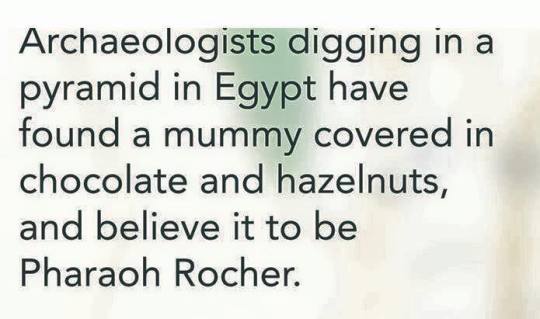In response to the picture below, seen on Facebook (and admittedly barely managing a groan even from me), I nevertheless felt inspired and pretended it was true. I wrote this article, suggesting ground-breaking findings were to come in the story of the world’s sweetest mummy…

BREAKING NEWS: NEW FIND BOGGLES ARCHAEOLOGISTS AND QUESTIONS MUCH OF WHAT IS KNOWN ABOUT HUMAN HISTORY
Cairo, Nov. 21st. 2015 – by Damien Concordel
Egypt was a powerful kingdom of the Antiquity, known the world over for its massive monumental stone constructions, from pyramids to temples to monolithic obelisks and gigantic statues.
But until now, nobody imagined quite how powerful the kingdom was. Nobody, that is, until Ms. Soledad Lunahierro, a little-known but influential archaeologist from Spain working in Egypt’s Valley of the Kings, stumbled on this one tomb with a very unusual mummy inside.
The mummy was found wrapped in a thin gold leaf shroud, 20m below any other tomb in that complex, in a chamber farther removed from all the others.
But what surprised Ms. Lunahierro wasn’t the gold leaf or how far down the tomb was: indeed, preliminary analyses of the mummy indicate that, prior to mummification and burial, the body of the pharaoh was covered in a mixture of chocolate and chopped hazelnuts!
This find has stunned Ms. Lunahierro and her colleagues, and led to a massive rethinking of what we knew of Ancient Egypt, its neighbors and their economic interactions.
“Many questions remain here. The problem is that, because this challenges some of our best-known information about the ancient kingdom, it’ll take that much more effort to solve the riddle. Much of what we know will have to be rebuilt and extrapolated again before we can even begin to tackle this new question.” says Ms. Lunahierro.
Carbon dating has shown the mummy to be from about 3,140 BC. But until now, no evidence existed to show that trans-Sahara trade was occurring in significant amounts, nor that cocoa beans were among the traded products.
More significantly still, chocolate was thought to have been invented as a result of the colonization of the Americas, but this new evidence points to the fact that the Ancient Egyptians made or knew of chocolate over 4,500 years before it was introduced into Europe.
Finally, researchers the world over are utterly baffled by how this mummy is even possible, because it would involve having found a way to preserve milk-based products for over 5,000 years.
Questions abound about this issue. An expert on Antiquity trade and economics, Mr. Joseph Sweeting, tells us, “Hazelnuts can have been imported by naval trade from Anatolia and the milk was produced locally. The cocoa beans are the real anomaly here, and it’ll take a lot more finds up and down the Nile river and across the Sahel to unearth traces of this antique cocoa trade.”
Mystery still surrounds this find, but regardless of whether any new evidence comes up to support it, this find will undoubtedly shake up our knowledge of the history of the region, which will be a sweet deal for archaeologists.
